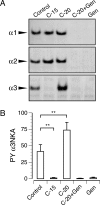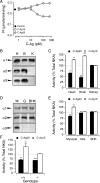Agrin regulation of alpha3 sodium-potassium ATPase activity modulates cardiac myocyte contraction
- PMID: 19376779
- PMCID: PMC2719333
- DOI: 10.1074/jbc.M806855200
Agrin regulation of alpha3 sodium-potassium ATPase activity modulates cardiac myocyte contraction
Abstract
Drugs that inhibit Na,K-ATPases, such as digoxin and ouabain, alter cardiac myocyte contractility. We recently demonstrated that agrin, a protein first identified at the vertebrate neuromuscular junction, binds to and regulates the activity of alpha3 subunit-containing isoforms of the Na,K-ATPase in the mammalian brain. Both agrin and the alpha3 Na,K-ATPase are expressed in heart, but their potential for interaction and effect on cardiac myocyte function was unknown. Here we show that agrin binds to the alpha3 subunit of the Na,K-ATPase in cardiac myocyte membranes, inducing tyrosine phosphorylation and inhibiting activity of the pump. Agrin also triggers a rapid increase in cytoplasmic Na(+) in cardiac myocytes, suggesting a role in cardiac myocyte function. Consistent with this hypothesis, spontaneous contraction frequencies of cultured cardiac myocytes prepared from mice in which agrin expression is blocked by mutation of the Agrn gene are significantly higher than in the wild type. The Agrn mutant phenotype is rescued by acute treatment with recombinant agrin. Furthermore, exposure of wild type myocytes to an agrin antagonist phenocopies the Agrn mutation. These data demonstrate that the basal frequency of myocyte contraction depends on endogenous agrin-alpha3 Na,K-ATPase interaction and suggest that agrin modulation of the alpha3 Na,K-ATPase is important in regulating heart function.
Figures






Similar articles
-
Regulation of cardiac myocyte contractility by phospholemman: Na+/Ca2+ exchange versus Na+ -K+ -ATPase.Am J Physiol Heart Circ Physiol. 2008 Oct;295(4):H1615-25. doi: 10.1152/ajpheart.00287.2008. Epub 2008 Aug 15. Am J Physiol Heart Circ Physiol. 2008. PMID: 18708446 Free PMC article.
-
Genetic suppression of agrin reduces mania-like behavior in Na+ , K+ -ATPase α3 mutant mice.Genes Brain Behav. 2012 Jun;11(4):436-43. doi: 10.1111/j.1601-183X.2012.00800.x. Epub 2012 May 11. Genes Brain Behav. 2012. PMID: 22520507
-
Alpha3Na+/K+-ATPase is a neuronal receptor for agrin.Cell. 2006 Apr 21;125(2):359-69. doi: 10.1016/j.cell.2006.01.052. Cell. 2006. PMID: 16630822
-
Physiological role of the alpha1- and alpha2-isoforms of the Na+-K+-ATPase and biological significance of their cardiac glycoside binding site.Am J Physiol Regul Integr Comp Physiol. 2006 Mar;290(3):R524-8. doi: 10.1152/ajpregu.00838.2005. Am J Physiol Regul Integr Comp Physiol. 2006. PMID: 16467499 Review.
-
The cardiac sodium pump: structure and function.Basic Res Cardiol. 2002;97 Suppl 1:I19-24. doi: 10.1007/s003950200024. Basic Res Cardiol. 2002. PMID: 12479229 Review.
Cited by
-
A structural overview of the plasma membrane Na+,K+-ATPase and H+-ATPase ion pumps.Nat Rev Mol Cell Biol. 2011 Jan;12(1):60-70. doi: 10.1038/nrm3031. Nat Rev Mol Cell Biol. 2011. PMID: 21179061 Review.
-
Clinical rationale for dietary lutein supplementation in long COVID and mRNA vaccine injury syndromes.F1000Res. 2024 Oct 17;13:191. doi: 10.12688/f1000research.143517.3. eCollection 2024. F1000Res. 2024. PMID: 39526116 Free PMC article. Review.
-
Biallelic variants in AGRN in a family with recurrent pregnancy losses and fetal akinesia deformation sequence.Clin Dysmorphol. 2025 Apr 1;34(2):25-31. doi: 10.1097/MCD.0000000000000517. Epub 2025 Jan 10. Clin Dysmorphol. 2025. PMID: 39807604 Free PMC article.
-
New role for Agrin in T cells and its potential importance in immune system regulation.Arthritis Res Ther. 2010;12(2):205. doi: 10.1186/ar2957. Epub 2010 Apr 12. Arthritis Res Ther. 2010. PMID: 20398335 Free PMC article. Review.
-
Basic Biology of Extracellular Matrix in the Cardiovascular System, Part 1/4: JACC Focus Seminar.J Am Coll Cardiol. 2020 May 5;75(17):2169-2188. doi: 10.1016/j.jacc.2020.03.024. J Am Coll Cardiol. 2020. PMID: 32354384 Free PMC article. Review.
References
Publication types
MeSH terms
Substances
Grants and funding
LinkOut - more resources
Full Text Sources
Other Literature Sources
Molecular Biology Databases

